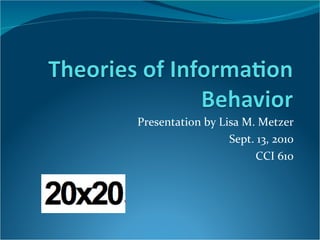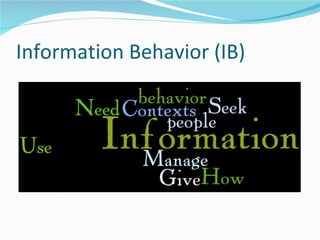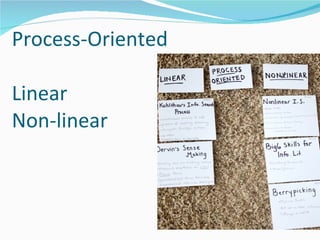Theories of Information Behavior
- 1. Presentation by Lisa M. Metzer Sept. 13, 2010 CCI 610
- 2. Purpose Explore the 72 conceptual frameworks in I.S. Consider: What have we learned? WhatŌĆÖs missing?
- 3. ╠²
- 4. 72 Entries
- 8. Classifying
- 9. Concepts Context/Situation Intentional vs. Accidental Viewpoint ŌĆō Cognitive, Social, Affective, Behavioral System vs. User Process: Linear vs. Nonlinear Web/Digital Queries Critical Other
- 12. Cognitive ŌĆō Social ŌĆō Affective - Behavioral
- 15. Web / Digital
- 17. Other
- 18. What have we learned?
- 20. Implications for future research ŌĆ£ Working with conceptual frameworks and empirical research has never been easy.ŌĆØ (Chatman, 1996, p. 205)
Editor's Notes
- #2: Introduce topic of my presentation.
- #4: Edited by Karen E. Fisher, Sanda Erdelez, and Lynne McKechnie. Copyright 2005 by American Society for Information Science and Technology. ASIST monograph. Collaborative work of the information behavior community. Purpose of book = facilitate theory building and use. ResearcherŌĆÖs guide.
- #5: A practical overview of the 72 current conceptual frameworks in Information Science. Both newly proposed and well-established. International effort by 85 scholars from 10 countries. Each entry follows a similar format. Alpha order by theory name.
- #6: Would communication theories be included in the 31% social sciences?
- #7: As defined in this book: How people need, seek, manage, give, and use information in contexts.
- #8: My goal was to organize the theories conceptually (as opposed to alpha order). Why? To clarify conceptually whatŌĆÖs been done and whatŌĆÖs missing. Methods: Read the preface and three introductory papers. Read each entry. Create an index card for each entry. Name of theory and key points. Brainstorm concepts/variables. Arrange the theories conceptually.
- #9: Limits: Misinterpretation of theories or terms. More than one way to classify each theory (subjective). How to define the terms for consistent use (operationalize) . Construct validity. Time restraints.
- #11: Example theories include: Everyday: Practice of everyday life; ChatmanŌĆÖs life in the round, Serious leisure Work/task: Information activities in work tasks; Cognitive work analysis, General model of information seeking of professionals Functional: Optimal foraging, Principle of least effort
- #12: Examples: Intentional: Information intents, Monitoring and blunting, PAIN hypothesis Accidental: Information encountering, Ecological theory of human information behavior, Information acquiring-and-sharing
- #13: Cognitive: TaylorŌĆÖs question-negotiation, Anomalous states of knowledge (ASK) Social / Constructionist: VygotskyŌĆÖs zone of proximal development, strength of weak ties, social positioning Affective: Library anxiety, Flow theory, Affective load
- #14: System: Value sensitive DESIGN (could also be user-centered as it relates to a personŌĆÖs values ŌĆō open to discussion) User: Willingness to return, Phenomenography, Reader response theory
- #15: Linear: KuhlthauŌĆÖs information search process, DervinŌĆÖs sense making, Big6 skills for information literacy Non-linear: Nonlinear information seeking, Berrypicking (or is it linear??)
- #16: Web: World wide web information seeking, Web information behaviorŌĆÖs of organizational workers, Network gatekeeping
- #17: Queries: Imposed query, Elicitation as micro-level information seeking Critical: symbolic violence, ChatmanŌĆÖs information poverty
- #18: Diffusion theory, Trans-theoretical model of health behavior change, Archival intelligence
- #19: Overview ŌĆō summarize whatŌĆÖs been done.
- #20: Looked at too may variables at one time. Hard to see whatŌĆÖs missing! Personal information management Domain specific Empirical validation of some of the theories Test some of the theories with specific groups of people Question asking Info exchange and sharing
- #21: Control variables for consideration ŌĆō not so many at once. Consider one variable at a time, i.e. user vs. system-oriented or by viewpoints. Try different arrangements.




















